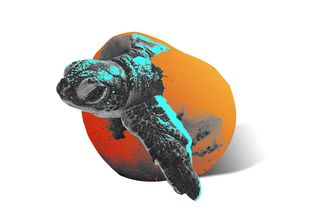
Sea Turtles Born in Florida Are All Females Due to Severe Heatwaves, Say Scientists
“…you’re going to see a sharp decline in their population because we just don’t have the genetic diversity,” the researchers said.

The sea turtles found on Florida beaches are resilient and powerful. Called loggerheads, their log-shaped heads hold together anatomy that makes them among the most abundant species of sea turtles in the region. But there is something awry afoot in recent years: scientists say most of the sea turtles born in Florida over the last four years were predominantly female.
The observed pattern in sea turtle reproduction is linked to rising heatwaves and growing temperatures — it may be too warm for male turtles to develop. Previously, researchers in Australia observed a similar design too: almost 99% of turtle hatchlings on the Raine Island — located on the outer edges of the Great Barrier Reef — were female. The researchers dug historical data to correlate sea and air temperatures with the sand temperatures, and looked into whether that impacted the sex of the turtle. “Combining our results with temperature data show that the northern GBR green turtle rookeries have been producing primarily females for more than two decades and that the complete feminization of this population is possible in the near future,” the authors write in the paper, which was published in Current Biologyin 2018.
In other words, the climate crisis is impacting the biological sex of the sea turtle hatchlings at a rate faster than they can adapt. The implications of this changing reproductive landscape are both for the individual species as well as the larger ecosystem that surrounds them; more worryingly, it speaks to the unique and unprecedented ways the crisis is forever altering how species live, mate, and survive.
Sea turtles nest along beaches, when turtle mothers bury their eggs in the sand to incubate before hatching. The sex or gender of the baby turtle is determined by the temperature of the sand, which influences that of the developing eggs. If the egg incubates at temperatures lower than 27 degrees, chances are the young hatchling will be a male sea turtle. Anything above 31 degrees and a female turtle will be born. This may vary depending on the geography and exact species variations, but between 27 and 31 degrees, scientists think there is an equal likelihood of it being male or female hatchlings.
As Florida encountered record-breaking heat waves over the last few years, more and more female turtles were born on its beaches. Even in 2019, one scientist in Miami foundthere to be only female hatchings over the last decade. In other parts of the world, such asCape Verde off the coast of West Africa, there was a link between the sex of the hatchling and the sand temperatures.
Related on The Swaddle:
Divorce Rates in Albatrosses May Be Rising Due to Climate Change: Study
A higher ratio of female sea turtles may impact patterns of reproduction among the local population. “Over the years, you’re going to see a sharp decline in their population because we just don’t have the genetic diversity,” said Melissa Rosales Rodriguez, a sea turtle keeper in Miami. “We don’t have the male-to-female ratio needed in order to be able to have successful breeding sessions.” This is a question researchers are increasingly asking themselves: what happens when there are not enough male turtles coming up as adults? Will the population survive?
At first, the higher female nesting and changing ratio may lead to an increase in population, as male turtles may reproduce with multiple females. But this may soon be followed by a decline “as incubation temperatures approach lethal levels,” a 2018 study noted. The current estimate is that while there will be almost 32-64% more nesting females by the year 2120, these female hatchlings may also suffer a higher risk of fatalities in warmer conditions.
The Australian researchers also predicted, “that very soon the [northern Great Barrier Reef] population will start to see reduced fertility at the nesting beach if it is not already happening.” Moreover, the species may suffer a genetic loss and eventually be stunted due to changes in fertility.
The impact on incubation and sex outcomes of hatchlings is not limited to sea turtles alone. “As the Earth experiences climate change, increased temperatures could result in skewed and even lethal incubation conditions, which would impact turtle species and other reptiles,” the National Ocean Service said. Nesting and hatching will get significantly riskier and even fatal as temperatures soar. One implication is also with respect to biodiversity; their neighbors depend on sea turtles for the stability of the marine ecosystem. Among other things, sea turtles help manage prey; the eggs and hatchlings also leave behind important nutrients that help sustain coastal vegetation. Green turtles even graze on seagrass which eventually becomes a way to keep seagrass beds healthy.
Species, both unique and common, are struggling to adapt to the deleterious pace of changing climate and extreme weather. Sea turtles that nest on beaches undisturbed are bound to be forever disrupted, a cycle triggered by human-induced changes. As Bette Zirkelbach, manager at Turtle Hospital, said: “Sea turtles have been on our planet for over 110 million years…they have evolved and survived our oceans for over 110 million years. They were swimming in our oceans when dinosaurs were on our lands, so it’s really hard to even think about or conceive as a human to think about that [their eventual loss].”
Saumya Kalia is an Associate Editor at The Swaddle. Her journalism and writing explore issues of social justice, digital sub-cultures, media ecosystem, literature, and memory as they cut across socio-cultural periods. You can reach her at @Saumya_Kalia.
Related


Scientists Revive Cells, Organs in Dead Pigs — Hinting at the Possibility of ‘Reversible Death’
